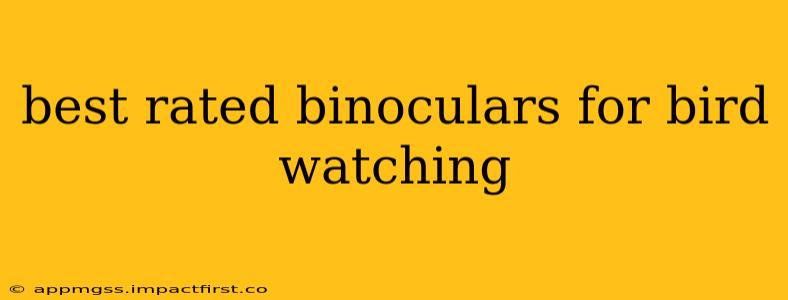Bird watching, or birding, is a captivating hobby enjoyed by millions worldwide. Spotting that elusive warbler or identifying a distant hawk relies heavily on the quality of your binoculars. Choosing the right pair can significantly enhance your birding experience, transforming it from a challenging pursuit into a rewarding adventure. This guide explores the top-rated binoculars for bird watching, considering various factors to help you find the perfect pair.
What to Look for in Birdwatching Binoculars?
Before diving into specific models, let's address the key features that make binoculars ideal for bird watching:
-
Magnification: This is represented by the first number in the binocular's specifications (e.g., 8x42). Higher magnification (e.g., 10x) brings distant birds closer, but it can also reduce the field of view and make image stabilization more challenging. 8x or 10x magnification is generally considered optimal for bird watching.
-
Objective Lens Diameter: The second number (e.g., 42 in 8x42) indicates the diameter of the objective lens in millimeters. Larger lenses gather more light, resulting in brighter images, particularly useful in low-light conditions or dawn/dusk viewing. 42mm is a popular choice, offering a good balance between brightness and portability.
-
Field of View: This refers to the area you can see through the binoculars. A wider field of view is advantageous for tracking fast-moving birds or scanning a large area.
-
Close Focus: The ability to focus on subjects very close to you can be beneficial for observing smaller birds in bushes or trees.
-
Image Stabilization: Some binoculars incorporate image stabilization technology, helpful for handheld viewing, especially at higher magnifications.
-
Weight and Size: Consider the weight and size, especially if you'll be carrying them for extended periods. Lightweight, compact binoculars are preferable for long hikes.
-
Durability: Look for binoculars made from robust materials that can withstand the rigors of outdoor use. Waterproofing and fog-proofing are also valuable features.
H2: What are the Best Binoculars for Beginners?
Beginners often benefit from binoculars with a balance of magnification and field of view. Models with 8x42 specifications frequently provide a good starting point, offering sufficient magnification for clear viewing without sacrificing too much field of view. Look for options that are relatively lightweight and easy to use. Prioritizing durability and ease of use over extremely high-end features is usually a smart choice for those just starting out.
H2: What are the best binoculars for bird watching at long distances?
For long-distance viewing, higher magnification (e.g., 10x) is desirable. However, keep in mind that higher magnification requires steadier hands or image stabilization to avoid blurry images. Larger objective lenses (e.g., 50mm or 56mm) will gather more light, making them better suited for low-light conditions or viewing distant birds.
H2: What is the best magnification for bird watching binoculars?
The ideal magnification for birdwatching is often debated. 8x and 10x are popular choices. 8x provides a wider field of view, making it easier to track birds in flight, while 10x brings distant birds closer, offering better detail. The best choice depends on individual preferences and viewing conditions.
H2: What are some top-rated brands of binoculars for bird watching?
Several brands consistently receive high praise for their birdwatching binoculars. Some of the most reputable include Nikon, Canon, Vortex, Zeiss, and Leica. These brands offer a range of models catering to various budgets and needs, ensuring there's a suitable option for every birder. Research reviews and compare specifications before making a purchase.
H2: How much should I spend on binoculars for bird watching?
The price range for binoculars varies significantly, from a few hundred dollars to several thousand. While higher-priced models often offer superior optics and features, excellent binoculars can be found at more moderate price points. Set a budget based on your needs and prioritize features that are most important to you. Remember, the best binocular is the one you'll actually use consistently.
Conclusion:
Selecting the best binoculars for bird watching depends on your individual needs and preferences. By considering magnification, objective lens diameter, field of view, close focus, image stabilization, weight, size, and durability, you can choose a pair that will significantly enhance your birding experience. Remember to read reviews, compare models, and prioritize features that best suit your birding style. Happy birding!
